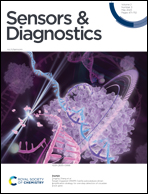Braided copper cobaltite/MWCNT composites enable acetylcholine detection at sub-nanomolar levels in vitro†
Abstract
Developing a sensor for neurotransmitter detection is of paramount medical importance in the early diagnosis of neurological and psychiatric disorders and monitoring the treatment efficacy of drugs targeting the cholinergic system. To address this need, we present a non-enzymatic electrochemical sensor based on a copper cobaltite/MWCNT composite for detecting acetylcholine, a neurotransmitter found in human body fluids. The sensor utilises a bisolvent interface-assisted synthesis technique to produce highly crystalline braided networks of copper cobaltite, which were subsequently characterised using high-resolution transmission electron microscopy (HRTEM) to study their evolution and crystallinity. The composite-modified sensor exhibited outstanding detection capabilities with a limit of detection (LOD) of 0.8 nM, superior selectivity in the presence of interfering molecules, and exceptional stability. To miniaturise the bulky three-electrode system, an all-integrated flexible sensor was fabricated and was successfully employed to detect acetylcholine released by sub-cultured human neural cells, demonstrating its potential for real-time diagnostic applications.



 Please wait while we load your content...
Please wait while we load your content...